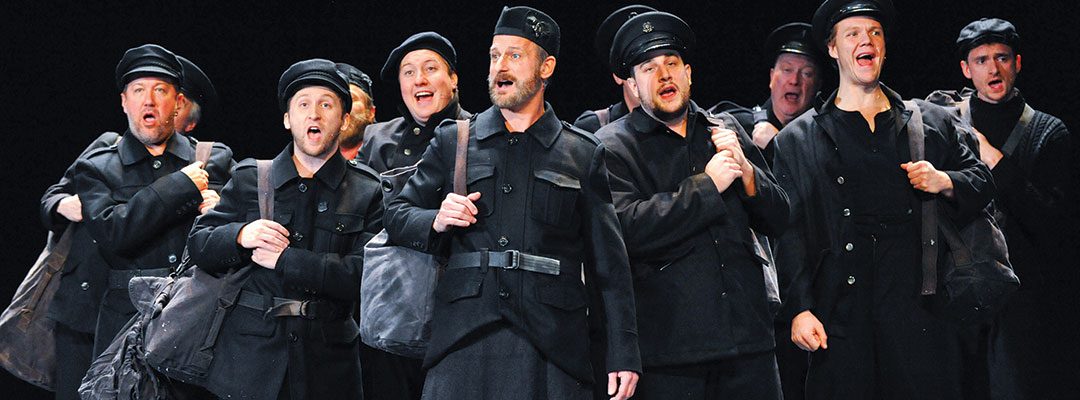All IS CALM – MAN’S HUMANITY TO MAN
– By Cary K. & Victoria Conover –
From the joyous times of Thanksgiving’s blessings we marched into somber reality. Not our somber reality but that of the trench soldiers of World War I. It seemed the audience of the Rosemary Clausen Center for Performing Arts had been forewarned of the ominous topic. The lights seemed lower, the crowd less vocal, theater-goers more workmanlike in their resolve to get seated. The muffled sounds gave way to quiet and darkness.
The stage vacant, then an eerie mist of uncertainty until a single sole voice began a melancholy Irish tune and then multiplied in perfect harmony until reaching a full, assembled sound. Thus begins “All is Calm, The Christmas Truce of 1914.” The ten men, a Minneapolis-based troupe, began by walking us through eager portions of the war-making process using songs like, “Call to Arms,” “God Save the King” and “It’s a Long Way to Tipperary,” while using generous excerpts from soldier’s letters, diary entries, and even war documents throughout the evening. From great beginning enthusiasm to marching, rain, and sorrow.
This was reality, their grim reality of the “Great War,” the “War to End All Wars,” the First World War. Many had been promised they’d be back home by Christmas and didn’t bring suitable clothing. But here they were, Christmas Eve, killing neighboring men in an opposing trench. The Clausen Center audience was silently asked to participate: feel, absorb, empathize, commiserate, and sympathize. And they did. There were, if fact, times when the audience could have applauded but all seemed to understand the drama unfolding, the barren truth of a circumstance long removed. The stark, black stage empty, save some dark-stained, wooden military-type boxes, fit nicely with the soldiers’ clothing – each with his own unique black or drab olive or drab brown or drab green uniform. Their performance was powerful – dark, somber, and haunting.
And the a cappella singing . . . was magnificent! Each of the talented gentlemen had training and backgrounds in classical music. Their vitas were filled from Lyric Opera Kansas City to Sweeney Todd to Repertory Theater of St. Louis to Les Miserables. And summed up by one theater-goer as, “I could have listened to them all night!”
But the reality was there, always, in “No Man’s Land,” the enemy so close you could hear them coughing. Lyrics such as, “If you want to find the whole battalion, I know where they are . . . hanging on the ol’ barb wire, I see ‘em,” or “I don’t want to die, I want to go home.”
But then Christmas Eve 1914, an amazing transformation began with a single German voice singing “Stille Nacht,” converting enemies into just other humans, also disillusioned, cold, hurting, and wanting camaraderie and peace. Evolving from combatants into Father Christmases sharing their gifts of tobacco, chocolate, and even rum, these spur-of-the-moment philanthropists sang “O Tannenbaum,” “Lo, How a Rose ere Blooming,” and “Silent Night,” utilizing a soaring, high tenor descant. With the introduction of a “famous Paris tenor”, he sang “O Holy Night” in absolute perfection, and songs like the moving “Lo, How a Rose” followed by “Auld Lang Syne” continued the vocal offerings.
This was a story of men, common men from the lowest ranks sharing a common human experience of sorrow for sure, but more than that, sharing hope. Hope for all men. Hope at Christmas. Perfectly portrayed, perfectly performed, and perfectly presented to a solemn, sensitive and appreciative audience about a time we never knew or knew too little about. Thank you, Theater Latt’e Da. The performance was summed up by cast member, James ‘Jim’ Ramlet, saying, “It is an honor to tell the story.” No Jim, the honor was ours.

